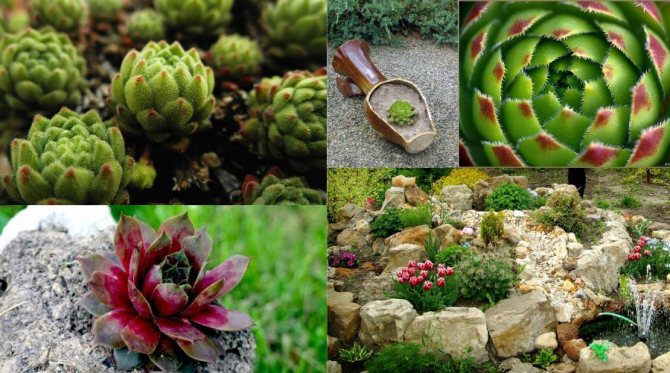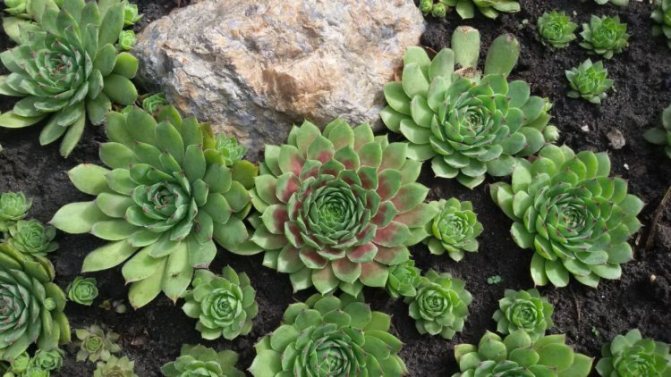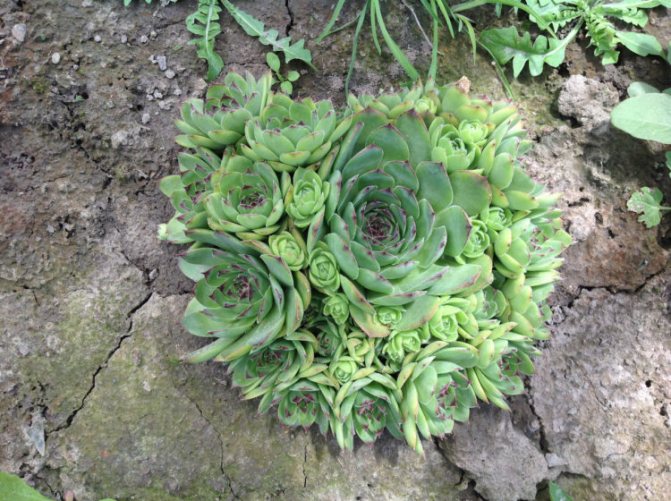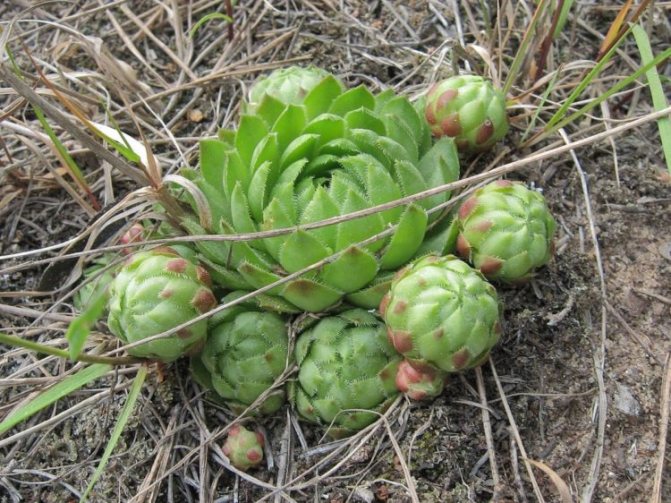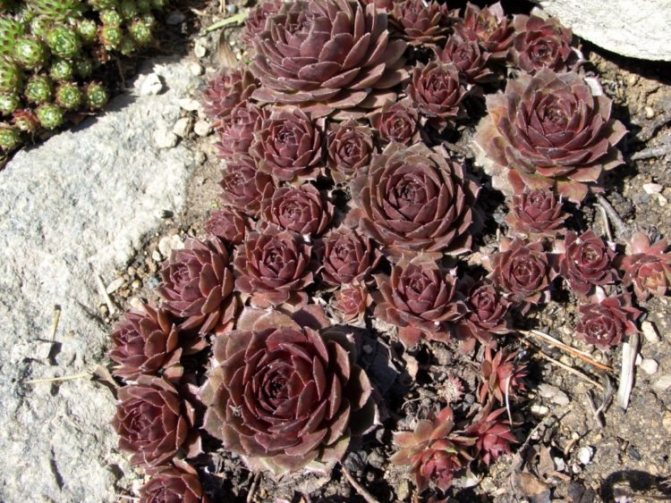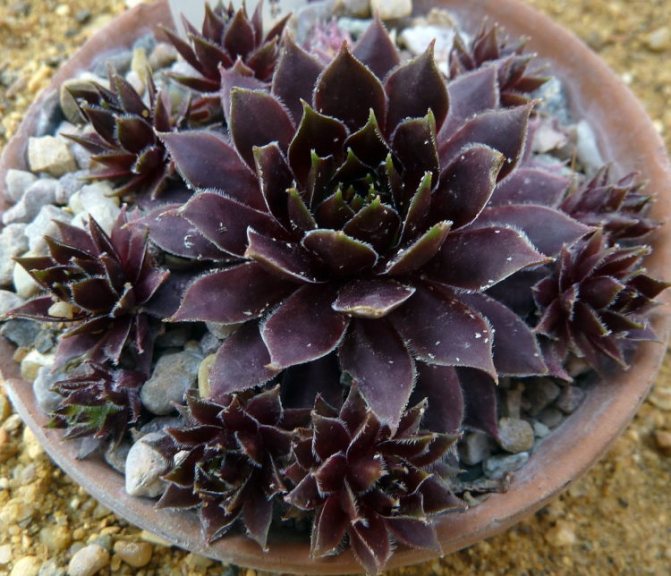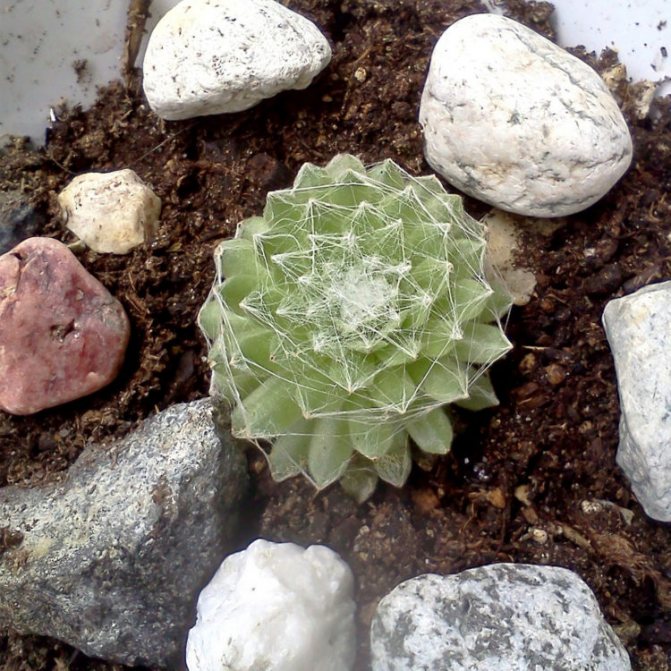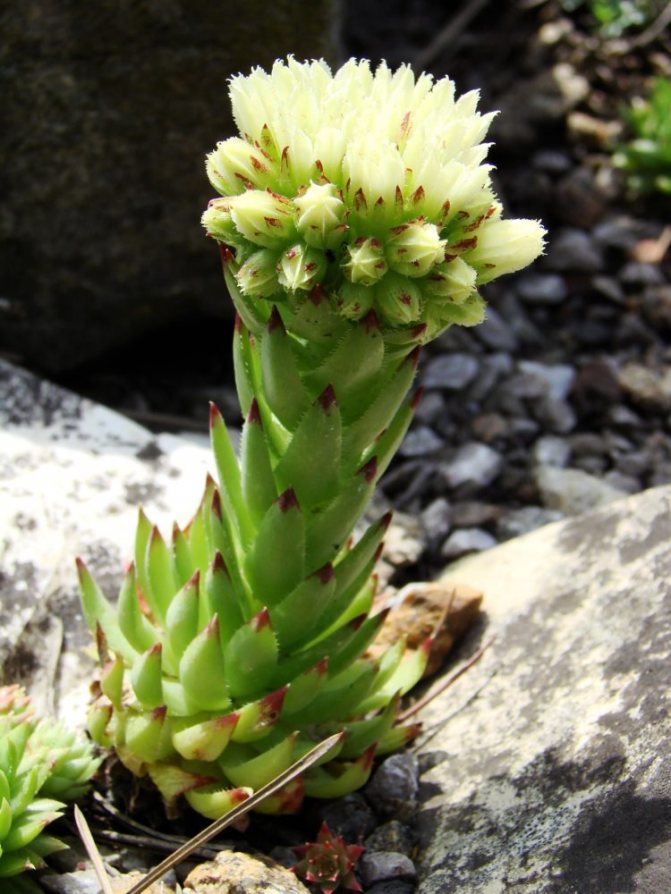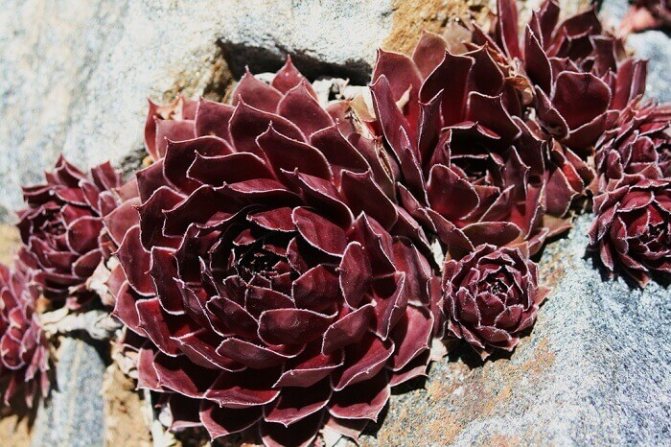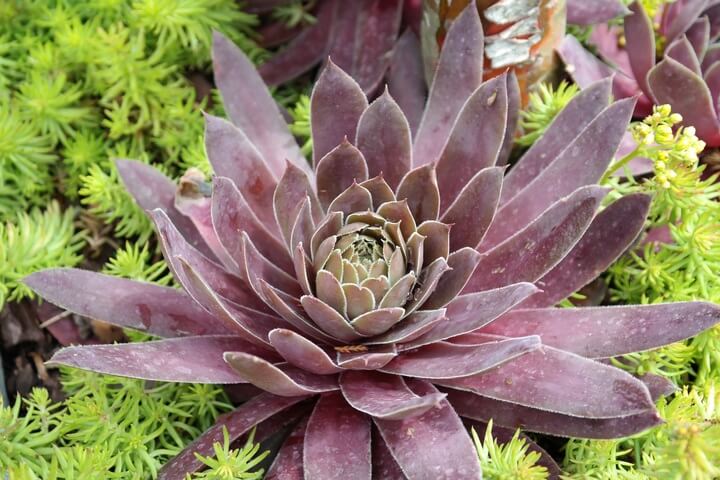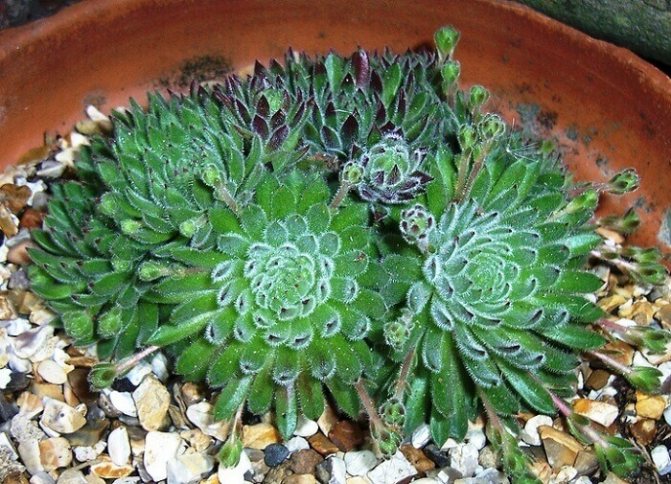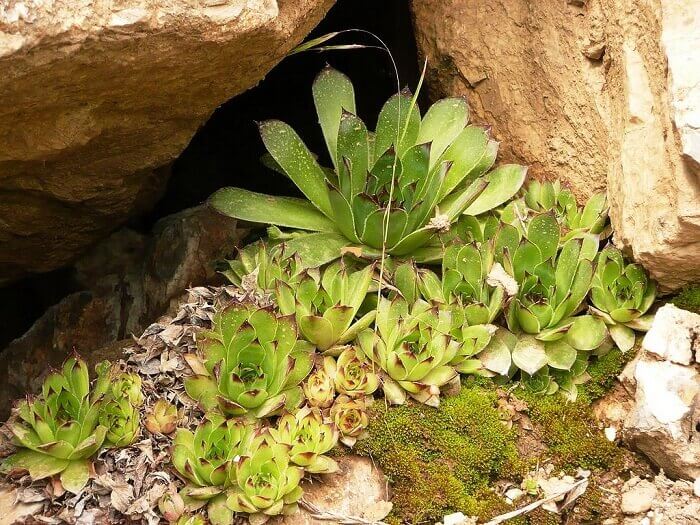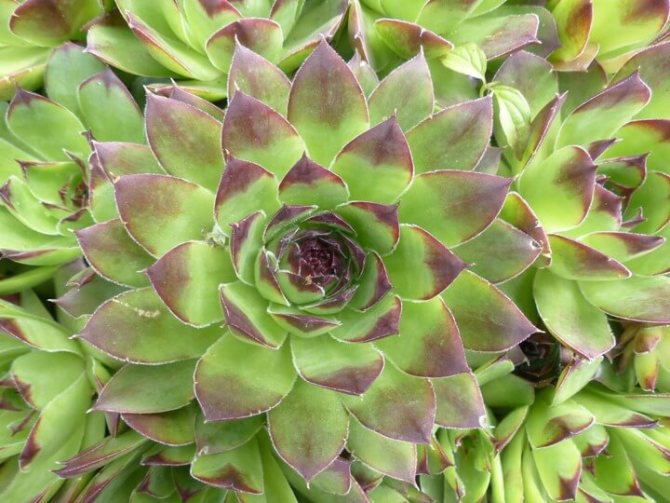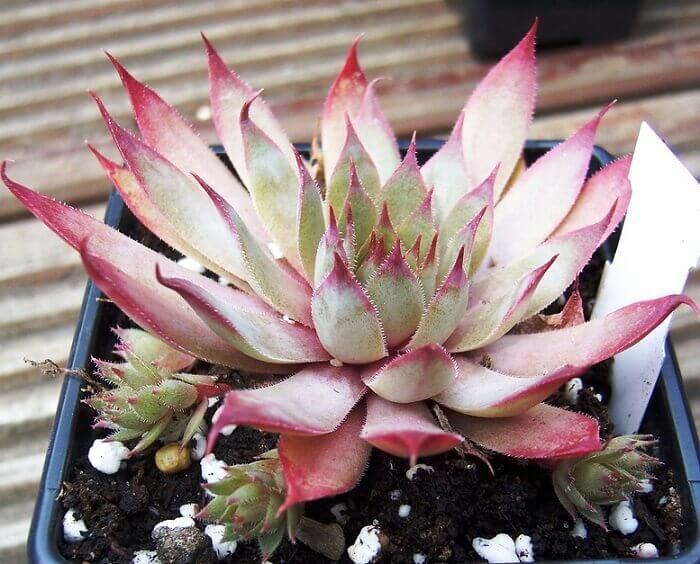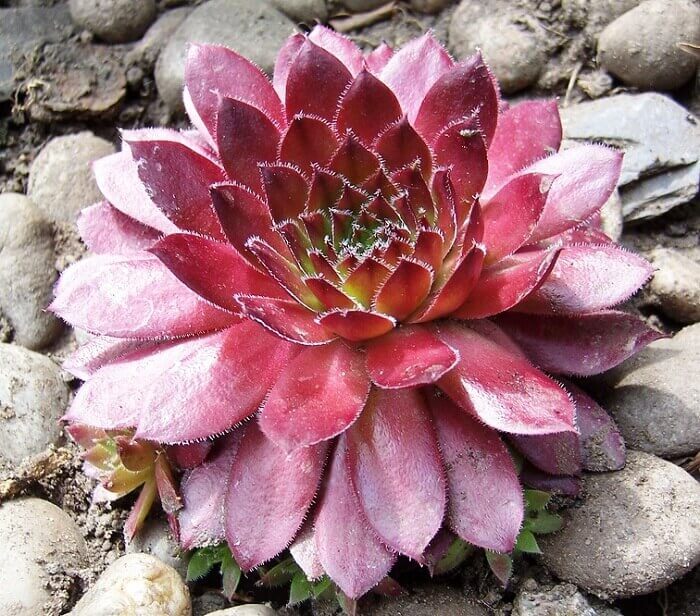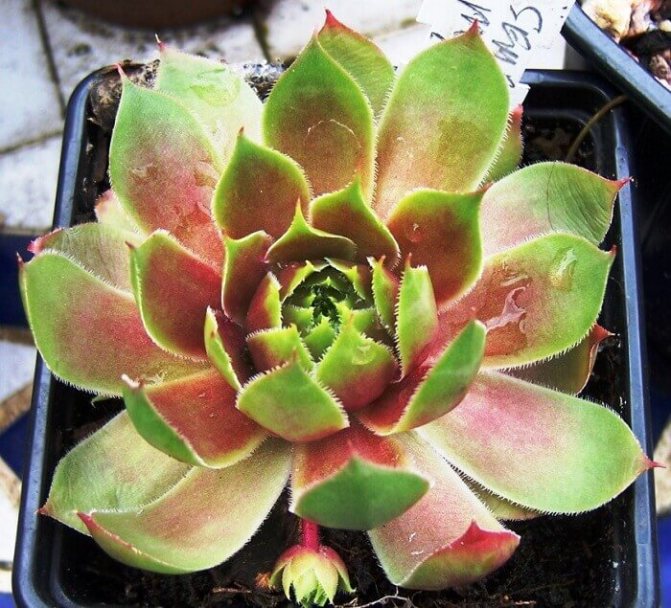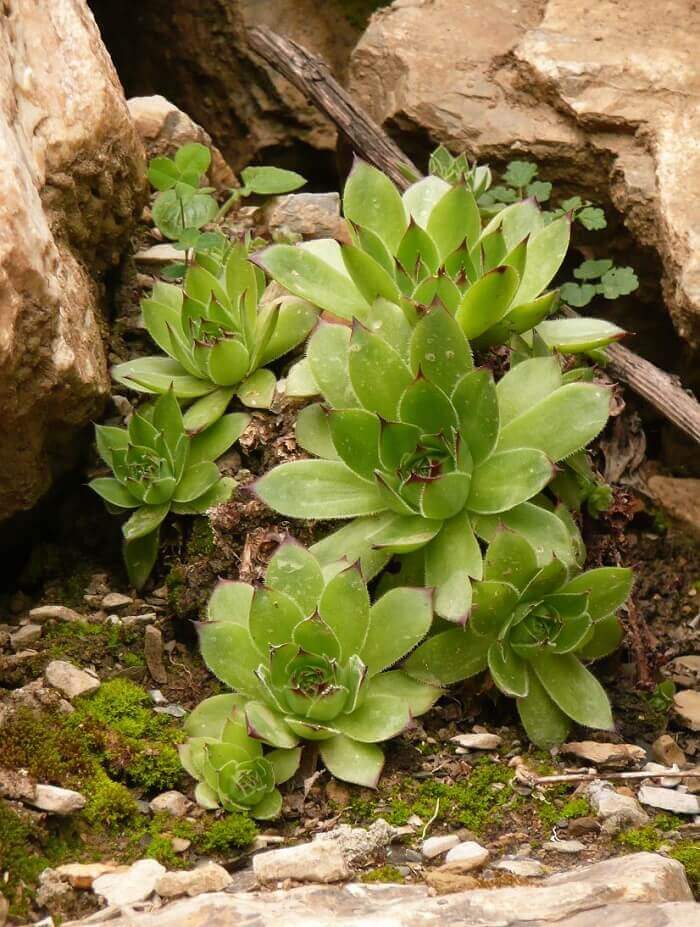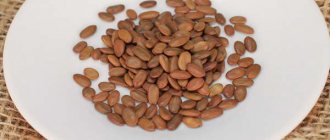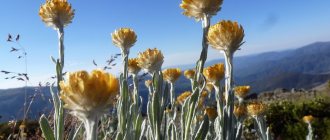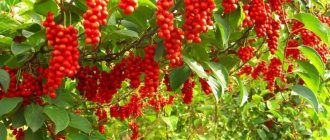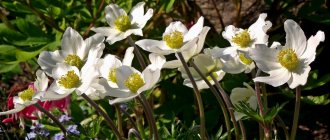
The Tolstyankov family.
Rejuvenated (Sempervivum) is popularly called a stone rose, just look at this flower, as there are associations with the queen of the garden. This is due to the structure of the succulent rosettes. In addition, it is a very hardy plant that can grow and develop even in harsh conditions. The stone rose does not need watering and fertilizing, it can grow even on poor soil, and the rosettes quickly take root upon contact with the ground. In view of such unpretentiousness, this plant is suitable for breeding even for beginners. Many species and varieties of juveniles are grown in gardens and the plots planted with this succulent look quite impressive and unusual.
Under natural conditions, the young grows mainly in the mountainous regions of Asia, in the Caucasus, in Central, Southern and Eastern Europe.
The genus includes about 40 species. There are numerous species of juveniles with different colors of leaves (green in different shades, ruby-red, bronze-red, with brown leaf edges, etc.). The rejuvenated cobweb (Sempervivum arachnoideum) looks very unusual, the rosette of which is covered with a white "cobweb".
Nuances of care
Although a stone rose is considered an unpretentious plant, there are some nuances of flower care:
- At home do not water the plant from above... It is impossible for the water to fall on the leaves, otherwise they can rot. In winter, watering should be reduced: once every 2 weeks is enough.
- Top dressing is needed only for a home flower, which is more than 3 years old. In the open field, you do not need to feed the saxifrage at all... Usually, cow dung or poultry manure is used as fertilizer. It is diluted with water and the plant is watered with infusion.
Rejuvenated loves light... In the open field, try not to plant it in shady areas.
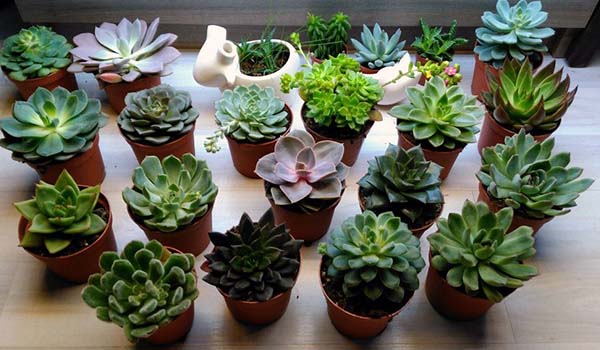

Rejuvenated calmly tolerates both drought and frost.
Growing young in a pot under indoor conditions
If anyone thinks that a stone rose is such a flower that grows only in an outdoor garden, then this is a mistake. This plant also thrives in pots indoors.
It is not whimsical at all and will grow well in any soil, even poor in minerals. Watering sparingly will also not harm the plant. And besides, rejuvenated feels great even in the driest air.
Another advantage of a stone rose is that it is not afraid of pests, it rarely gets sick. But even despite all the advantages, there are several recommendations on how to keep a plant in a house or apartment:
- do not place it in a dark place that is not illuminated by sunlight. The rejuvenated loves the sun's rays, if the sun is not enough, then the rejuvenated will brighten and lose its bright appearance.
- water the plant no more than once every two weeks and try to keep no drops of water on the outlets.
- in midday heat, place the pot in the shade.
- in summer, put a stone rose in a pot on a balcony or yard.


Rejuvenated grows well in indoor conditions
What hurts, who hurts
The main disease of saxifrage is rot, which occurs due to an excess of moisture - the main enemy of the flower. To the main pests include birds, worms and beetle larvae... If rot is found, remove the affected area and reduce watering - the main cause of rot.
If the plants are damaged by birds (crows, magpies, jackdaws), just dig in the flower pulled out by the bird. So that flying pests do not damage the flower, put a scarecrow in the garden... It is more difficult to fight the larvae. Because they are not visible. Domestic flowers have no pests.
What soil is needed for a stone rose
Rejuvenated grows well on different soils. Fertility does not play a special role in the development of the plant, however, excess moisture can lead to rotting of the rosettes.


If the land does not allow water to pass through well, it is pre-drained.
Expanded clay or broken brick is poured at the bottom of the planting pit 20–30 cm deep. Dolomite flour is introduced into acidic lands in autumn.
Too dense soil is mixed with sand and vermiculite is added.
When planting, the rosettes are not deepened, they are simply sprinkled with loose soil.
The distance between them should be at least fifteen centimeters. In the open field, the young take root in a few weeks.
Bloom
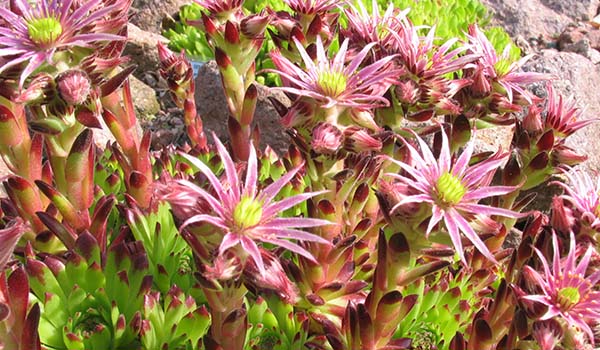

2-3 years after planting, the stone rose blooms. The plant produces a peduncle. It happens in August... Different varieties have different flower colors:
After flowering, the plant dies offtherefore, saxifrage is rarely more than 3 years old. This is compensated by the abundance of babies that grow nearby, and therefore the death of the mother plant is often invisible. The pedicel must be removed after flowering.if you don't plan on collecting seeds.
Winter is a period of dormancy for a plant both at home and in nature. This time of year saxifrage does not bloom or reproduce.
Selecting and preparing a landing site
Rejuvenated belongs to succulent plants. In nature, they grow in places with an arid climate and are able to accumulate moisture in foliage.
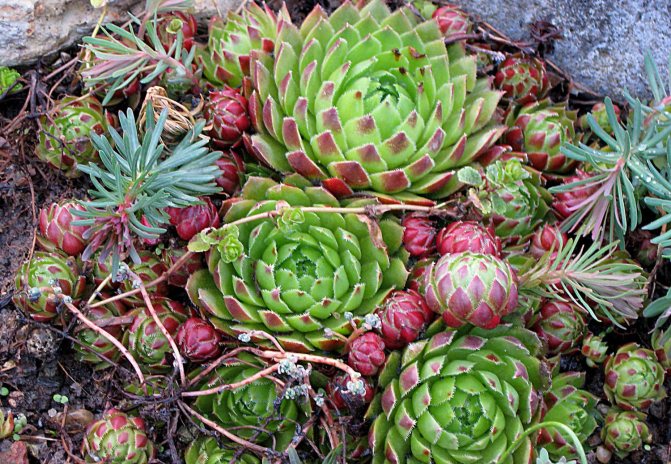

In the garden, it is better to plant a stone rose in a sunny place. It is the amount of light that affects the color of the foliage and the number of outlets.
A strong shadow will lead to the fact that over time the plant will lose its shape, turn pale.
Hybrids may die altogether. Avoid places with close groundwater table.
The tenacious can be planted in the ground from May to September.
They dig up the future flower bed, break up clods of earth, get rid of the roots of weeds.
Sand, peat and leafy soil are introduced into heavy loamy soils.
Tall plants are bad neighbors for a succulent. They will shade the young.
Healing properties rejuvenated
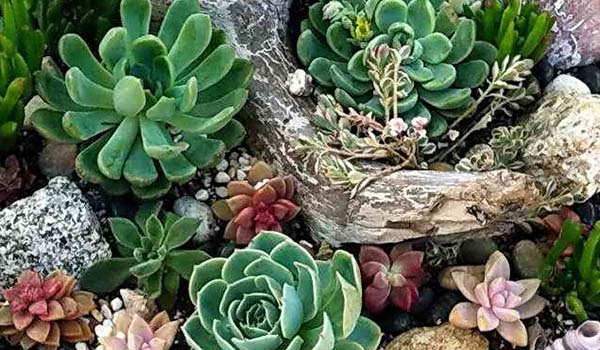

The medicinal properties of the plant have been undeservedly forgotten! BUT quarry leaves can be used in folk medicine for the preparation of decoctions, ointments, infusions. The flower has such healing effects:
- anesthetic,
- disinfectant,
- healing,
- calming,
- anti-inflammatory.
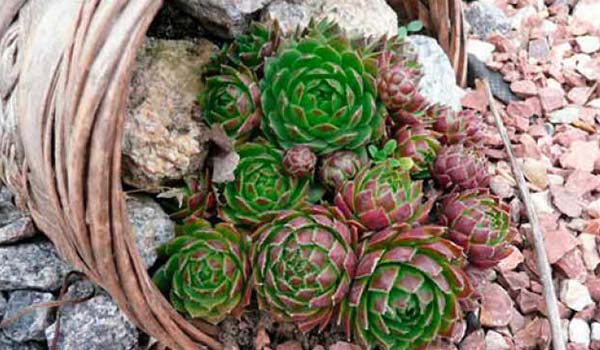

Interesting that no contraindications for taking medications based on the plant have been identified. Although an allergic reaction to the components of the flower is possible, overdose should be avoided when it comes to ingestion. Do not use infusions from the plant for pregnant and lactating mothers... Not recommended for children under three years of age.
Medicines from the young used for such diseases:
- stomach ulcer, gastritis,
- female pain
- skin problems
- heat.
- inflammation in the mouth,
- cardiovascular problems
- epilepsy,
- diseases of the eyes and ears.
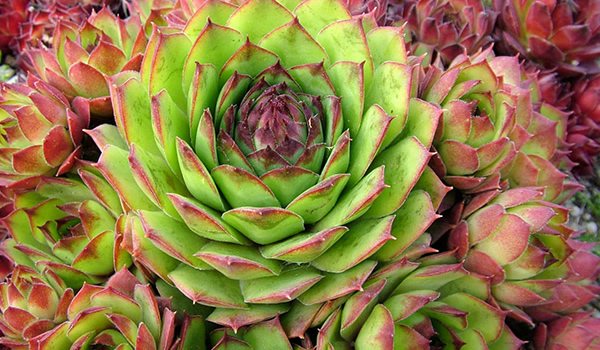

To prepare ointments, you need to take the leaves of a flower, crush them and apply the gruel to the sore spot: wound, calluses, wart, blister from an insect bite. Juice rejuvenates whitens the skin, reduces freckles and age spots.
Rinse your mouth with a decoction of the leavesif there are wounds or is taken orally to treat ulcers. The broth is also used to remove worms and treat hemorrhoids.
Diseases and pests
Gray rot is fatal to the plant. Fungal disease appears in conditions of waterlogged soil.
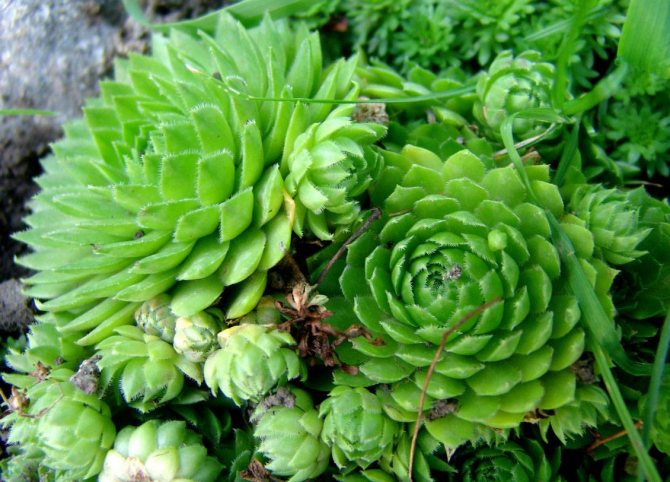

Fleshy leaves, covered with dark bloom, become soft to the touch and then dry out.
The disease can become epidemic and destroy all plantings.
For the prevention and treatment of plants, flower beds are treated with fungicides "Gamair", "Skor", "Topaz".
The roots of the stone rose attract the May beetle. In the spring, the soil in the flower beds is well loosened.
If a parasite is found, the soil is spilled with the preparations "Antichrushch", "Bazudin", "Zemlin".
The succulent foliage is a tasty morsel for aphids. Numerous colonies can cause irreparable damage to landings.
If small insects are found, the rosettes are sprayed with insecticides "Vermitek", "Fufanon", "Confidor".
Rejuvenated and landscaping
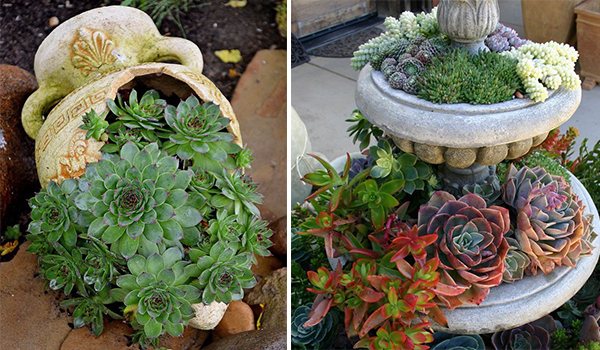

Florists, summer residents and landscape designers have long noticed a stone rose and actively use the beauty of the flower in landscape design and household plots. Due to the different color of the leaves, the flower can be used on alpine slides, make rows and patterns and even evergreen carpets from rejuvenated.
In landscape design, a stone rose is used for planting:
- In pots. Often the pot is inverted and the plant is planted in the form of a stream from a pot.
- In barrels. Top and side as decoration.
- Next to the garden figurines.
- In the form of a decorative curb along the paths.
- They are planted in a rocky garden or on a hill (rockery) to dilute the stones with plants.


Sometimes people plant the young in the cemetery as a substitute for artificial turf or to decorate graves.
In design different types of flower are beautifully combined, but it is not recommended to plant it with some plants. These are lush flowers and bushes covering the sun. The flower is combined with the same undersized plants such as sedum, moss, thyme and other soil-bearing plants.
And still young can replace cabbage in soup and baked as a side dish... Keep this in mind if you get lost in the woods.
Here are how many interesting and unusual qualities and properties an ordinary plant has rejuvenating that you may not have even noticed before.
Rejuvenated - an ideal plant for a sunny area with poor soil. He has several popular names: stone rose, thunderbolt, hare cabbage, tenacious, fat woman. Planting and caring for the young in the open field is not difficult, since it is very unpretentious. It is an ideal plant for beginner gardeners.
How to grow rejuvenated from seeds?
Plant propagates sockets, but it can also be grown from seeds, although new species and varieties do not grow very beautiful, but there are exceptions in everything. This process is time-consuming and requires a lot of effort, but the results are worth it.
When you see that the work invested by you pleases not only you, but also everyone around you, this is true happiness. You can plant seeds in winter, so that they take root better and adapt to temperatures, and in spring, to grow more intensively, and even in the hot summer period.


Rejuvenated reproduces by rosettes
You can plant it directly in the place designated for it, or in pre-prepared pots. It is much easier to grow rejuvenated in indoor conditions, it is protected from various influences from outside. Seeds are sown on the surface, without deepening, in order for them to germinate faster, you need to water the soil very carefully, because the seedlings are very thin, miniature, which sometimes cannot even be distinguished from a young, just hatched grass.
When the sprouts grow and get stronger, a rosette will begin to form, which after a certain period will begin to grow and children will appear that need to be cut off. So from a small grain such a beautiful plant grows over time.


Rejuvenated will delight you with its beauty
Having planted it once, you will not be able to deny yourself the pleasure of enjoying its flowering, and the courtyard decorated with its help will be filled with a mysterious, fabulous atmosphere.
You can pick up a series of varieties with different, but well-combined shades by choosing interesting containers for this: old baskets, clay pots, old shoes, tractor tires, and so on. For beauty, you can decorate them with different colors. Fill your life with bright colors!
General description of the bush
Rejuvenated refers to perennial ground cover succulents. It has a rosette structure of fleshy leaves. Their diameter varies from 1 to 20 centimeters. Leaves are dense, glabrous or pubescent with glandular hairs. The fibrous rhizome is located in the upper layer of the soil.
The leaf plate, depending on the variety, is painted in different colors: green, silver, red-burgundy. The flowers bloom in the young in June-August, have a delicate aroma. Reproduction is carried out by children, which the plant can throw at a distance of about 1 meter.
Echeveria and youthful differences
Quite often, people think that rejuvenation and echeveria are one and the same flower, but this is a misconception. They belong to the same family, so they are a bit similar. But there are differences in them:
- Rejuvenated more frost-resistant... It will feel great on the street at subzero temperatures, and echeveria, on the contrary, does not tolerate low temperatures, it needs to be stored only warm.
- The rejuvenated releases antennae, while echeveria does not have such a feature.
- Echeveria has a stem, while the young do not have it.
- The leaves of the Sempervivum are thinner and more graceful in appearance, in contrast to Echeveria. And the flowers of these two plants are different.
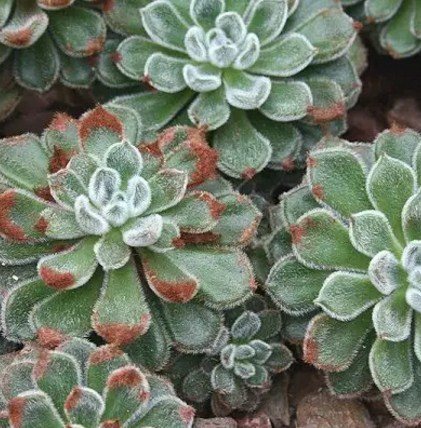

Echeveria, not to be confused with a young man
So, if you want a more unpretentious and hardy plant with respect to temperature conditions, you should choose a young one.
Varieties and varieties rejuvenated
The main species of rejuvenated species existing in nature:
- Roofing. Plants are spherical or slightly flattened in shape, the diameter of the rosettes is 4-15 centimeters. It begins to bloom from mid-July to late August.
- Russian. The diameter of the plant is up to 6 centimeters. Inflorescences are yellow, grow up to 35 centimeters.
- Cobweb. The name of this species was rejuvenated for the glandular hairs that envelop a small (up to 4 centimeters in diameter) rosette.
- Marble. The rosettes of the plant reach 10 centimeters. Young leaf plates are slightly pubescent; the color at the base is green, smoothly turning into red.
- Spherical. The leaf plates are young, oblong-spatulate, collected in a socket, the size of which is 5 centimeters.
- Caucasian. In height, the leaves of the plant reach 20 centimeters, the width of the rosette is 5 centimeters. The inflorescences are lilac-purple in color.
The most popular varieties are young:
- Pharaoh. The height of the rosette is 10 centimeters, the leaf plates are purple, with small gleams of green.
- Princess. The plant has tightly closed leaves with dark brown tips.
- Montana. The rosettes were large, their color is bright green.
- Yulia. At first, the leaf plates of the bushes have a marsh color, which changes to red by autumn.
- Ed. The peculiarity of the planting is in small red rosettes.
The names of popular species and varieties of young (with photo)
Today, there are about 4 thousand popular varieties of stone roses. The color of the rosettes can be green, yellowish, silver, pink, burgundy. Sometimes the color of the leaves changes during the season. Rejuvenated easily hybridize with each other, so trying to determine which variety is in front of you is almost impossible.
Below are the names of the most popular species and varieties of rejuvenation with a photo, which will help a gardener who is not yet familiar with this culture to assess how it will look on the site and for which compositions it is suitable.
The mountain (Sempervivum montanum) was rejuvenated.
This species is easily recognized by its numerous pointed leaves with cilia along the edges. Dark green leaves form dense rosettes 3-4 cm in diameter. In the second half of summer, low (5-20 cm) peduncles with inflorescences of open star-shaped flowers 3-4 cm in diameter are extended above the rosettes. The color of the flowers is bluish-purple or bright pink, darker in the center of the petals. The juice of the rejuvenated mountain has an unpleasant odor.
Young Caucasian (Sempervivum caucasicum).
Differs in large rosettes of succulent oblong leaves and shields of pink-lilac flowers blooming at the very beginning of summer. The height of the peduncles is 10–20 cm.
Roofing (Sempervivum tectorum) was rejuvenated.
Smooth green leaves with purple tips form flattened wide-open rosettes 8 cm high and up to 30 cm in diameter, and sometimes even more. There are garden forms with blue, brown and deep purple leaves. Flowers are small, 13-petaled, carmine red or pale purple in color; in captivity are rarely formed.
The winged (Sempervivum altum) was rejuvenated.
Dark green leaves are covered with glandular hairs on both sides. Leaves live for 1.5–2 years and acquire a reddish tint in autumn. The species is shade-tolerant, but develops extremely slowly in conditions of insufficient lighting.
Rejuvenated marble, or Schlehan, (Sempervivum marmoreum, syn. Sempervivum schlehanii).
Flat rosettes up to 10 cm in diameter from wide bluish-green leaves with a short styloid process at the end and beautiful wide-open pink-red stem leaves with a white border and cilia along the edges.
The upper surface of the leaves of young plants is covered with soft fluff. Flowering occurs in the first half of summer. Flowers of 4-6 pieces form twigs, which, in turn, in twos or threes, are collected in dense inflorescences at the ends of short peduncles.
The offspring (Sempervivum soboliferum) was rejuvenated.
Smooth pointed light green leaves form small (up to 5 cm in diameter) spherical, almost closed rosettes, above which short stalks with yellow-green flowers stretch out at the beginning of summer. The view looks spectacular on an alpine lawn.
Alpine young cobweb (cobweb) (Sempervivum arachnoideum).
Numerous tiny (2–3 cm in diameter) at first green, but by autumn, reddening spherical rosettes are covered with hairs as thin as a cobweb. The species blooms beautifully in the second half of June with pink or carmine-red flowers.
Rejuvenated spherical
Succulent perennial. Non-flowering shoots are shortened, in the form of dense spherical rosettes of fleshy leaves, 1-5 cm in diameter. The leaves of the rosettes are glabrous, ciliate at the edges, oblong-obovate, wedge-shaped at the base, shortly pointed, bright green, sessile. Flowering stem 10-40 cm tall, with a rosette of leaves at the base, leafy, glandular pubescent. Stem leaves are spaced, alternate, oblong-lanceolate. The inflorescence is corymbose-paniculate, multi-flowered, 5-7 cm in diameter. The flowers are pale yellow or greenish, six-membered, divisible. The sepals are glandularly pubescent, the petals are twice as long as the calyx. The fruit is a multileaf. The seeds are small and numerous. Blooms in July - August. Bears fruit in August. It reproduces mainly vegetatively, due to the formation of small axillary rosettes, usually only a few individuals in a group bloom. Ecology
It grows in dry sparse pine forests, in forest glades and forest edges, on open hills and meadows on sandy soil, as well as on sandy slopes of indigenous river banks. It is found in small groups, but in places of growth it can form rather dense clusters.
Cultivation rules
In order for the plants to grow quickly and look decorative at the same time, you must initially choose the right place and soil for them, and take care of the bushes during the season.
Selecting and preparing a landing site
Rejuvenated - a light-loving plant, so the planting site should be well lit. In the shade, the leaf plates lose their brightness and attractiveness. They planted it on the site from March to October. The stone rose must have time to take root before the onset of frost. She takes root easily, quickly builds up numerous offspring.
What soil is needed for a stone rose
The root system of the plant is superficial, so the substrate is selected loose, with a predominance of sand. In too heavy and wet soil, the roots can rot. Rejuvenated will more easily endure drought than excessive moisture. For this reason, drainage is laid out in the planting pit, consisting of broken shards, expanded clay, small pebbles, and sand. If the bush is planted in a pot, then a substrate for cactus crops is acquired.
Planting process
The flower is planted in open ground as follows:
- a landing pit is dug;
- drainage is laid out on its bottom;
- loose soil is poured on top;
- seedlings are set in the middle of the hole, covered with the remaining soil.
If several bushes are planted, the distance between young specimens is maintained in the range of 5-7 centimeters, for older ones - 10-12 centimeters. The plantings are watered immediately, then again after 3 days.
How does the young breed reproduce?
This plant reproduces vegetatively. Small buds appear, and different lengths extend from them in different directions mustache shoots... Their maximum length can be 30 cm.
The rejuvenated grows very quickly and needs to be thinned periodically in order to have large flowers. Before planting the shoots, the ground is well watered.
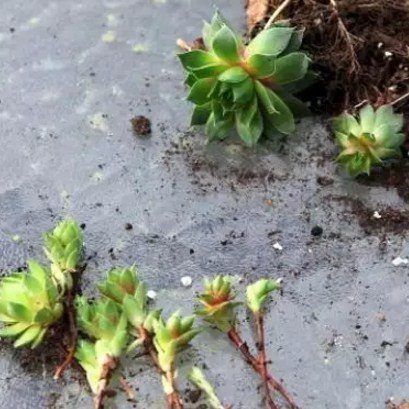

Rejuvenated reproduces vegetatively
If you want to breed this plant at home, then it is better to do this in the first months of spring, if you did not have time, then summer and the first months of autumn, before the first frost, are ideal for planting in the ground. The shoots take root in a new place within a month. Some shoots take root very well, while others get very sick, dry up and disappear, and in strong winds, they can be blown off, as they are weakly attached to the stem
How to care for a young man?
Caring for the plant is not very difficult. It is quite unpretentious, but for its spectacular appearance, it is necessary to fulfill the requirements. Rare watering, gentle loosening, removal of weeds and faded buds - these procedures will benefit the planting.
Watering rules
The leaves were young and fat, storing moisture. For this reason, the plant does not need frequent and abundant watering. Rainfall during the season is enough for him. With excessive watering, the plantation can be affected by fungal diseases.
Advice! The stone rose does not require frequent watering, so it is recommended to grow it in garden plots that are rarely visited by summer residents, as well as in regions that belong to the zone of risky farming.
Fertilization and feeding
Fertilization rejuvenated - not a mandatory procedure. Only adult plants can be fed - once a season, in spring. For this, fertilizer is taken for succulents in a dose that is half that for the rest of the plantings. Overly fed bushes may not survive the frosty winter.
How does culture winters?
The rejuvenated is able to endure large frosts without loss. The danger of wintering rejuvenated in the garden arises only due to the ingress of moisture between the leaf plates. With frequent thaws, the snow will melt, leaving water droplets in the stomata. Because of this, the plant can be affected by rot, due to which the leaf rosettes will die. To prevent this, when winter comes, they cover the young.
Large plastic bottles are used for cover. They are cut off, and the rosettes are covered with youth. To prevent the covering material from being blown away by the wind, it is fixed with metal studs.So that young plants can successfully winter, they are covered with spruce branches.
Rejuvenated - flower stone rose in the cemetery
People in modern society still treat the dead with respect and care. Therefore, very often you can see graves decorated with fresh flowers. But what kind of flowers to choose for planting in a cemetery? Many people are concerned about this issue.
Flowers for planting on the grave should be unpretentious, hardy and perennial, so as not to replant them every year and so that they decorate the graves of loved ones in early spring. They should not be afraid of drought, frost, or other weather changes.
Rejuvenated in this case is just perfect. And all because they can grow on any, even the worst soil. They are cold and drought resistant and require little maintenance.
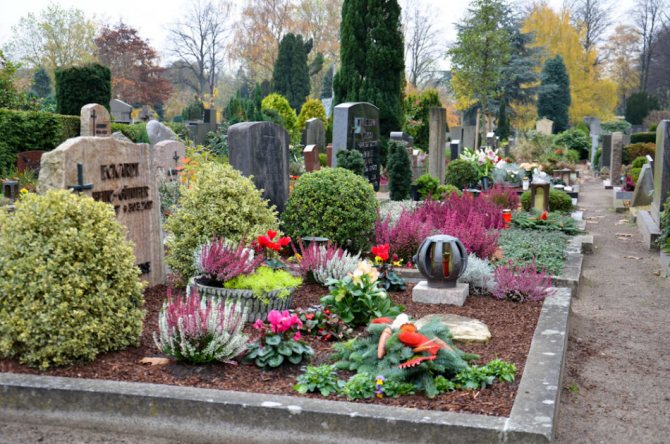

Rejuvenated are also planted in cemeteries
Nothing special is needed to grow this plant in a cemetery. Just plant the rosettes of the plant in the ground that has been well watered before. Well, at first, clean up on the grave, so as not to give an opportunity to germinate weeds. And then, after a short time, the young will adorn the graves of people dear to you.
Diseases and insect pests
Rejuvenated can get sick due to improper care, namely, too frequent watering. The plant begins to rot, infecting nearby bushes. To avoid this, the affected plantings are removed from the flower bed. The land on which the diseased grew young should be sprayed with a fungicide.
Birds can damage plantings. They peck out young, weakly adhering bushes, and scatter them around the site. In addition to birds, beetle larvae harm plantings. Pests are removed from the flower bed manually, the plants are re-rooted.
Also, aphid colonies can stick around a stone rose, which will suck juice from the plant. Rejuvenated will gradually begin to wither for a long time. The mealybug works in a similar way. To get rid of pests, the bushes are sprayed with an insecticide.
Note to the florist
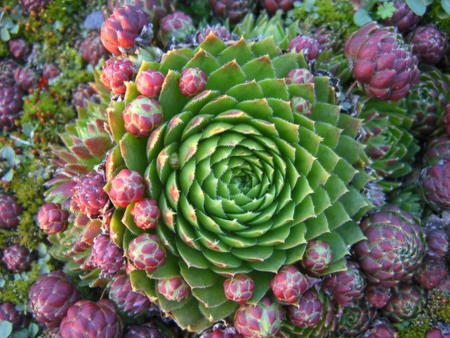

Why does not the young grow up?
- Problems with plant growth arise, as a rule, when the growing conditions are not followed. For example, in conditions of high humidity, the root system of a flower rots. Also, the plant does not tolerate drafts. The rejuvenated often suffers from the invasion of May beetle and bird larvae.
How quickly does the young grow?
- Already during the first year of life, the young are greatly transformed and grow. In this case, there is a significant change in the shape of the rosette and its color. As a result, the rosette takes the form of a pubescent rose. The edge is not just a decorative decoration of a flower, these hairs collect and retain moisture, protecting the plant from the most severe drought. At the same time, special processes with buds are formed from the axils of the leaves, from which daughter rosettes develop. The final stage of development occurs in the second or third year - the rosette grows up to 30 cm in height and blooms. After seed formation, the mother rosette dries up.
Breeding technology
You can propagate the young by seeds, cuttings and children.
Seeds
You need to sow seeds immediately after collecting them at your site or purchasing them at a flower shop. The fresher they are, the faster they sprout and take root. Preparation and breeding of rejuvenated seeds is carried out as follows:
- Drainage is laid out at the bottom of the planting box.
- Above, earth is waking up for succulents.
- Seeds are sown in rows, 4 centimeters apart. They do not need to be covered with soil.
- The seed is sprayed from the spray gun.
- The box is covered with foil to create greenhouse conditions.
After about 10 days, the first shoots will appear. After that, the film is removed, the seedlings are provided with constant care. If necessary, they are thinned out to provide sufficient feeding area. When the bushes grow up, they can be planted in open ground or in a pot.
Cuttings
In this case, cuttings are leaf plates that are separated from the outlet, and after planting, they grow roots, turning into independent plants. The procedure for propagation by cuttings is as follows:
- Sheet plates are cut with a sharp disinfected knife.
- The sections are powdered with charcoal. This procedure will prevent them from rotting.
- Cuttings are placed to dry for 2 weeks in a dry place.
- Each leaf is planted in a box with wet sand, covered with foil.
The seedlings are ventilated every day and, as necessary, watered. Care must be taken that the sand is not constantly wet. When roots and young rosettes are formed, the plants are planted in a permanent place.
Important! Cuttings after cutting are not planted immediately, but are left for 2 weeks in a dry place to dry.
Kids and mustache
Rejuvenated around itself forms young plants, which are called babies. For reproduction, they are separated with a sharp knife along with the root, which is dusted with a growth stimulator before planting. Children are planted in a place well-lit by the sun.
Instead of babies, some varieties of stone roses form stems with a vegetative bud at the end, which are called whiskers. So that they can take root faster, they are pressed to the ground, pinned, sprinkled with a substrate around them, watered. Soon the mustache will form roots, after which it is detached and transplanted to a permanent place.
How to keep young in winter: wintering in the open field
Rejuvenated - a plant resistant to low temperatures, frost. Therefore, even in winter you do not have to mess with it too much. It is not at all necessary to cover it for the winter, especially with a film. It will not freeze out, but in the spring, if the stone rose is under cover, there is a possibility that the plant will die due to the debate.


Rejuvenated quite resistant to frost
It is possible to cover with spruce branches only young plants that will winter on the street for the first time. In addition, professional gardeners are advised to protect valuable varieties of rejuvenated.
This can be done with a plastic bottle and then the youth will delight you for more than one year. If dry outlets are found in the spring, they should be removed and replaced with new ones. If you don’t do this, it’s okay, because it was young and it reproduces itself beautifully and quickly.
Rejuvenated: combination with other plants
The stone rose is loved by landscape designers for its beauty, unpretentiousness, and drought resistance. It can be planted on an alpine slide, in a rockery, along a garden path. Rejuvenated is used as a carpet, planting next to several varieties of plants of different color palette.
In addition, the bushes are combined with other drought-resistant plants: stonecrop, saxifrage, duchenea, arabis, purslane. Some gardeners plant it like a roof covering on a doghouse or gazebo, after having installed a special garden net on the roof. Also, mini-gardens on snags are made of them, planted in pots and pots.
Rejuvenated - landing
Planting rejuvenated in spring is carried out according to a simple algorithm>
- A sunny, well-lit area is chosen.
- A preliminary preparation of the soil is carried out: it is drained and sand is added.
- Follow the planting scheme, leaving 5-10 cm between the plants.
- Water the area to moisten the roots of succulents well.
How to plant young from seeds?
This method is rarely used, due to the fact that the seeds are small, like dust. Planting young seeds is a difficult procedure that requires care. The seeds should not be buried too deep; a simple indentation into the ground to a depth of 1 mm is enough. Seedlings appear quickly, but develop at a slow pace.
The optimal time for sowing is late winter, early spring, but if you want to experiment, you can choose another period.Special attention should be paid to soil preparation, especially if sowing will be carried out directly into open ground. Then the earth will have to be dug up, leveled, the seeds mixed with sand and scattered over the garden. An adult plant grower will receive an average of 12 months after sowing, the parental traits will not be inherited.
How to plant the young on the stones?
Growing conditions rejuvenated on stones in their natural habitat are tough. Succulent grows in cracks in stones, almost without soil and moisture. Thanks to these properties, the florist can create unusual compositions. It is not necessary to plant an entire garden with a huge amount of succulent, this is not an option when weeds fly from all directions in summer. Rejuvenated is an ideal plant for a garden of stones. Here they look harmonious and decorate the site. You can plant a succulent in crevices, on ledges and other holes in stones.
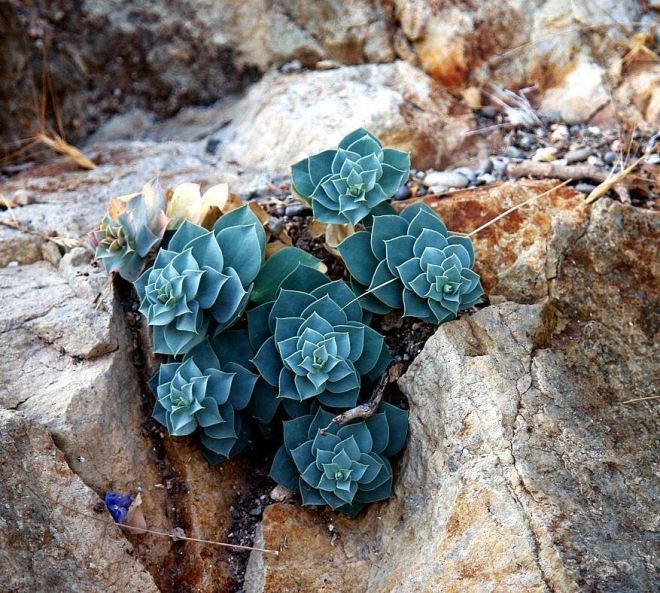

Use in the garden
The main application of Sempervivum is, of course, alpine slides and rockeries. Compositions from these plants can decorate any stone garden. They fit perfectly into any style and size.
Some varieties, with small rosettes and peduncles, are used for small rockeries. The number and variety of species and varieties allows you to make even a green carpet in the beds, as well as create separate small compositions.
A very popular hybrid variety is Pharaoh. It is always used in group plantings. All varieties and species of rejuvenated are in good harmony with saxifrage and stonecrop.
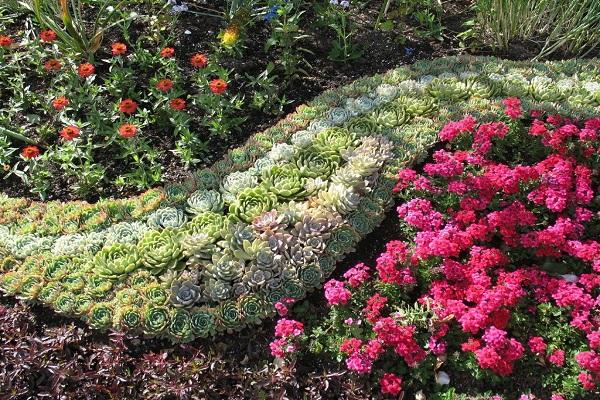

1. Seven Secrets of Success:
| 1. Growing temperature: during the growing season, the young are kept warm - at a temperature of 18 - 26 ° C, in winter a cool period of rest at a temperature of about 10 ° C is desirable. |
| 2. Lighting: it is unacceptable to get direct sunlight on the leaves during the day, the flower should take sun baths in the morning and evening, for several hours a day. |
| 3. Watering and humidity: the soil should be well moistened in spring and summer, however, between waterings it is dried to half the height of the pot, in the fall the frequency of watering is reduced. There is no need to increase the air humidity. |
| 4. Pruning: old, dried leaves are trimmed with a sharp, sterile instrument. |
| 5. Priming: nutrient-poor soil with excellent drainage and neutral or slightly alkaline pH. |
| 6. Top dressing: once a month during spring and summer. No feeding is carried out in autumn and winter. |
| 7. Reproduction: separation of daughter rosettes in spring and summer, spring sowing of seeds, leaf cuttings. |
Botanical name: Sempervivum.
Family... Crassy.
Origin... Southwest Europe, Africa.
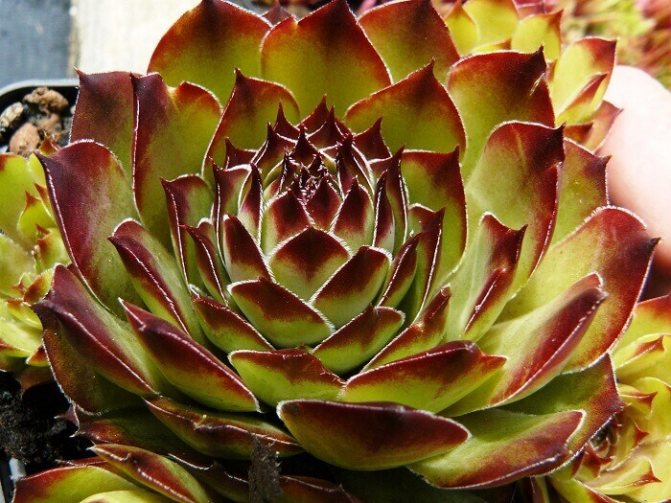

Description... The genus Sempervivum, rejuvenated, hare cabbage or stone rose (formerly tenacious) consists of about 40 species of rosette succulent plants.
Leaves triangular, pointed, green, bluish, bronze, burgundy and even blue. The leaves of some species are covered with pleasant pubescence. Leaves of many species will give off a pleasant scent when damaged.
Sempervivum refers to monocarpic plants - each of its rosettes, during the flowering period, throws out a tall, thick peduncleand then dies off.
At the top of the peduncle there are several yellow, pink, red or white flowers with 6 rounded petals.
Rejuvenated is also called "hen and chickens", as the large maternal rosette forms several small, young plants.
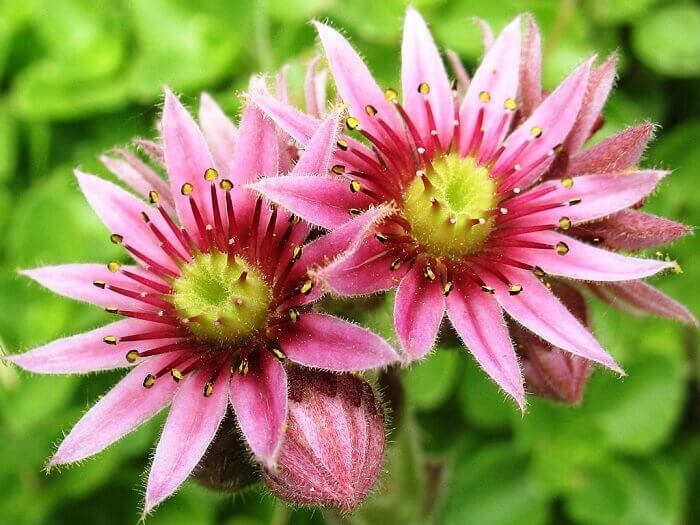

Height... The height of the leaf rosettes does not exceed 15 cm., peduncles reach 25 cm.
Recommendations
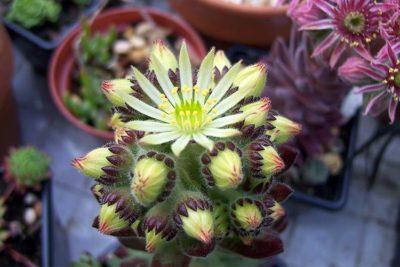

If the young does not bloom, but you really want to, then you need to arrange unfavorable conditions for the plant: drive into stress. A good stressful situation for rejuvenated will be the thickening of the plantings. Even very small rosettes can bloom in conditions of thickening of plants.
It so happens that a week or two passes, but there are still no shoots.You can continue to wait for shoots in the first container, since in rare cases shoots appear in a month. At this time, buy seeds from another supplier and again, observing all the technology of the growing process, achieve a good result.
You need to try, experiment, then everything will definitely work out. Sometimes housewives pour out the soil with seedlings that have not hatched to other flowers, and after a while they find young seedlings in other pots.
Description of the plant with a photo
Rejuvenated is an evergreen succulent herbaceous perennial with bare or glandular-pubescent fleshy leaves. Forms a dense basal leaf rosette, which is at the same time its vegetative shoot. The shape of sessile whole-edged leaves can be pointed and elongated, short and oval, and their color is very diverse. From light gray, pale pink and yellow to orange, purplish red, purple and almost black, most often in calm, muted tones. It can be the same over the entire surface of the leaf or with transitions between shades, with contrasting strokes, marbled color and silver fringe - it is this variety of colors and colors that allows enthusiastic florists to create whole picturesque paintings from the young. The surface of the sheet plate is glossy or matte, as if slightly powdered.
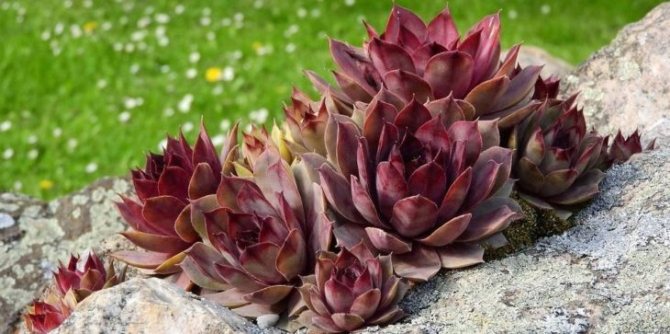

In the collection of juveniles, there are monstrose and cristate forms arising on the basis of anomalous development and irregular division of growth points. As a result of uneven vegetation, plants with absolutely fantastic outlines sometimes appear.
Growing lighting rejuvenated
Rejuvenated grows successfully both in the sun and in partial shade. But under different light conditions, it has a different color. In the bright sun, it is saturated-bright, but not large, and in the shade it reaches large sizes, but loses the brightness of color. In the spring, as soon as the snow melts in the garden, it can have a very bright color, but over time it will take on a normal appearance.
In the room, it is better to put it on the south window, although it will grow successfully on any one, but it may lose the brightness of the color.
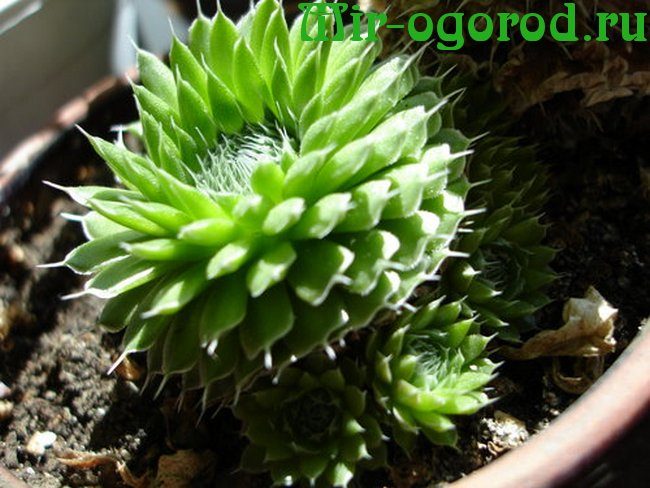

How to grow stone flowers. Rejuvenated: the most popular varieties
The stone rose belongs to the genus Tolstyanka, a family of succulents. All its types, and there are about thirty of them, are compact and unusually decorative. The flower grows in semicircular rosettes with fleshy leaves of different shades. In appearance, the plant itself looks like a bud of a blossoming rose. Hence the name - stone rose. Why stone? The flower itself seems to be carved from a precious green stone, and it grows best of all on rocky grounds.
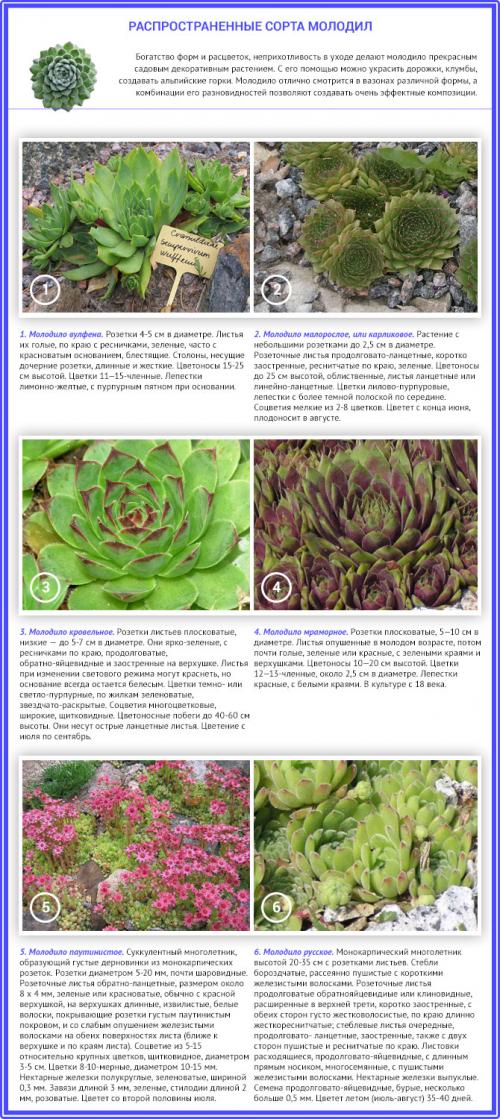

The following varieties are popular in our area:
- Roofing was young. This variety has large rosettes with oblong leaves, which have a burgundy color at the tips. The most popular varieties are shown in the photo.
- Wolfen. The plant is compact and suitable for all areas of your garden. The variety is prized for its delicate green leaves and beautiful lemon flowers.
- The Russian was rejuvenated. It can be found in forests, fields and hillsides. The rosette leaves are thin, dark green, and the flower itself has a flat shape. It is very easy to settle him in your garden. Just bring a plant from the forest with a small clod of earth and dig it into your flower bed. This variety does not require any care.
- Pitton was rejuvenated. There are several varieties of this rejuvenated. Russian flower growers fell in love with this variety for its unusually beautiful shade of leaves - from light green to dark plum.
- The marble was young. The leaves of this plant have several shades, iridescent like marble. This gorgeous flower will beautify any garden. See the photo.
Planting the young is not difficult at all. This "grateful" perennial that does not require care always obediently takes root in any place.
Features of planting a succulent
No wonder this plant was nicknamed "tenacious", it can grow even in rocky and poor soil.However, in order for the pets to feel good, attention should be paid to the correct planting of the young and the subsequent care suitable for the succulent.
For reproduction, two methods are used: by seeds and by means of vegetation:
Seeds
Not the most successful option, since only fresh seed gives seedlings, which eventually loses its germination capacity. It is best to sow freshly harvested or purchased seeds.
To keep the seeds fresh, it is recommended to place them in a tightly closed container that protects them from moisture and to store them in a cool place, away from direct sunlight.
The sunflower seeds are tiny, they are easy to wash off or blow off from the surface of the soil. Therefore, it is important to adhere to the recommended planting technology:
Planting in open soil.
Preliminary preparation of the soil is required at the sowing site. It should be thoroughly loosened, get rid of weeds. It is necessary to make depressions, at a distance of 3-5 cm from each other and place the seeds in them. It is not recommended to cover them with soil, it is enough to spray it with a spray bottle and crush it a little.
Sowing at home.
A wide container with low sides is taken, into which a 7-10 cm layer of soil mixture is placed - ready-made, intended for cacti and succulents, or prepared independently: from limestone, charcoal, peat, with the addition of sand. The seeding process is as follows:
- The soil should be compacted and moistened with water, you can also use Kornevin.
- The seeds are placed at a shallow depth and covered with a layer of lightweight substrate.
- To ensure greenhouse conditions, the tank is covered with glass or polyethylene.
- It should be left in a bright place and take care of a constant air temperature - 18 ° -22 ° C.
- It is important that the soil is constantly moist, and daily ventilation is also required.
- The cover can be removed after 14 days.
When the seedlings appear, they should be dived and planted in other pots.


Children
This method is considered to be simpler and more affordable - in nature, rejuvenation often reproduces in this way. If there is a desire to quickly increase the number of outlets, then it is better to resort to it.
Street landing
For rejuvenating, gardeners are advised to choose a sunny area on which the soil is prepared: it is cleared of weeds, loosened and moistened. If the earth is dense, oily, then it is recommended to remove 5-10 cm of the top layer and replace it with a peat-sand mixture - 1 part of peat is mixed with 3 parts of coarse sand.
Landing Algorithm:
- The rosette is carefully separated from the mother plant: the whiskers are captured, but the earthen lump is not removed. It is important that they already have developed roots.
- The sockets should be planted with an interval of 10-15 cm, just slightly melting them in the ground along with lumps of soil.
- The free ends of the mustache are dug in and watered carefully, water should not fall on the flower itself.
You can plant and "kids" without a mustache, but they will take root much longer. Further care for young growth when grown in the open field consists only of weeding - all weeds are removed. When the succulent grows stronger and grows, it should be looked after as an adult specimen.


Planting at home
The soil needs of a rock rose are very similar to those of other succulents - it should be loose and contain a lot of sand. You can use a ready-made cactus mixture. A 5-6 cm layer of expanded clay or other drainage material is poured onto the bottom of the pot, you can use a crumb of ordinary brick. Planting containers should have drainage holes.
The rhizome of a flower can be treated with a composition that stimulates its growth.
Disembarkation process:
- Small holes should be made, at a distance of 7-10 cm from each other.
- The root is completely immersed in the depression.
- Sprinkle it with soil and press down a little.
- The outlet is watered - gently from a syringe, under the root.
Further care consists in watering, this should be done regularly, but in moderation. Experienced gardeners advise every time to water the young with a 0.5% solution of fungicidal agents.
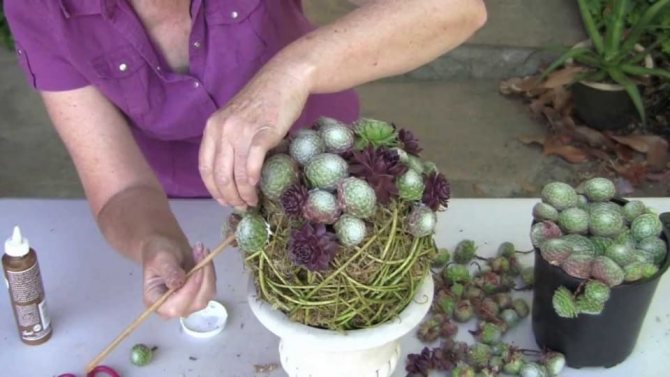

Features of home content
Roofing stone rose and other varieties are often grown in dwelling conditions. After all, such flowers look beautiful and, at the same time, do not require complex care. However, it is worth considering their special needs:
- Temperature conditions.
In this matter, the flower is very unpretentious, the main thing is that the thermometer does not drop to zero and below - the succulent dies in the cold. But even the intense heat tolerates perfectly.
- Watering.
In the summer period, 2 waterings per month are enough for the succulent, in the winter - one. The flower is watered only at the root, if moisture gets into the outlet, then it can rot and die.
- Lighting.
Ideally, if the young is illuminated by bright diffused sunlight. On a hot afternoon, it is better to provide it with additional shade.
- Pruning.
Rejuvenated roofing does not need it, as a rule, damaged, dried and withered leaves are removed.
It is important! Immediately after flowering, the inflorescences should be removed, since if the peduncle begins to dry out and fruits with seeds are formed, the deciduous rosette also dries up, which leads to the death of the flower.
- Fertilization.
Young growth is usually not fed; flowers over 3 years of age are fertilized. This should start in early spring, procedures are carried out every 4-8 weeks. It is better to use universal mixtures for cacti; it is recommended to dilute the recommended dosage by 2 times.
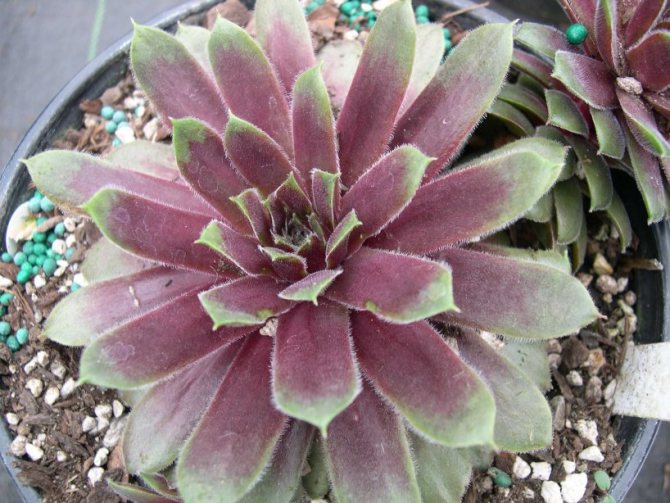

When to expect flowering?
- A week after sowing, the first seedlings hatch in discordant rows.
- After a month, all viable seeds germinate and slender green rows of the plant are visible in the container.
- After two months, the seedlings are shaped outlets that must be transplanted into separate containers.
- After three months, each rosette is rooted in its own container.
- Two years later, rarely a year later, the young bloom.
Each rosette rejuvenates blooms only once in a lifetime, and then dies off. Blooming takes life from the outlet. In place of the old dying outlet, many new baby outlets appear, which are seated in other containers. The flowering period is in the month of July. By the time the plant blooms for about 1 month.
general information
The genus rejuvenated (lat. Sempervivum) belongs to the jumbo family and consists of about 3 dozen species. The area of their growth is not wide; they are found in Europe, Asia Minor and the Caucasus. About 10 plant species are successfully cultivated in the middle Russian zone.
It is interesting! The youth received the nickname "stone rose" among the people, since its basal rosettes really look like frozen volumetric inflorescences.
In addition, the plant is called saxifrage, hare cabbage, tenacious, fat woman, thunderbolt. As for the name “rejuvenated”, it consists of 2 words, which are translated from Latin as “always alive”.


Soil preparation
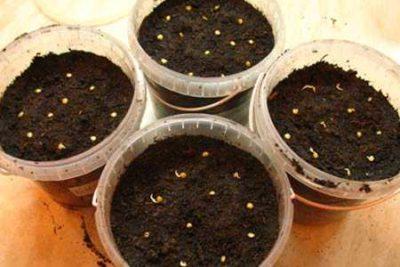

To plant seeds, it is necessary to fill shallow containers (3-4 cm deep) with a mixture of sand and peat chips (1: 1). Another option for soil: coarse washed river sand and garden soil in a ratio of about 2: 1.
If there is no possibility and desire to prepare soil for sowing seeds, you can choose ready-made soil for cacti and succulents in the store, but add a little charcoal to it, which will protect the root system from excess moisture and decay. In terms of chemical properties, the soil should not be acidic.
After filling the containers, the soil must be leveled and moistened with a weak solution of any biostimulant - Kornevin, Heteroauxin, Zircon (2-3 ml per 1 liter of water).
The purchase was rejuvenated
It is risky to buy a young one with a single large socket. She can bloom before she has time to give children.The flowering was rejuvenated - at the same time a joyful and tragic event in the life of this monocarpic plant. Monocarpic plants are such perennials that die after flowering and fruiting. Everything happens in the following order: the mother's rosette is pulled out, turning into a fleshy pedicel wrapped in hard leaves. Then the flowers bloom, collected in a corymbose-paniculate inflorescence. After the seeds ripen, the rosette dies off. The vacated "parental" place is eventually taken by growing children. Some of the tiny rosettes roll to the side and take root.


Rejuvenated on a stone wall
I would advise choosing smaller plants that will produce offspring before flowering. The average price of a pot of juveniles in large supermarkets and garden centers is 35 - 45 rubles. In some nurseries, it can go up to 80 - 100 rubles.
Breeding methods, their pros and cons
Reproduction of a stone rose at home can be done in two ways:
- vegetatively - with the help of child layers;
- from seeds.
Seeds
The main advantage is that this method is suitable for breeding new varieties. A variety of specimens can be grown from seeds obtained from one plant.
The disadvantages of this breeding method are as follows:
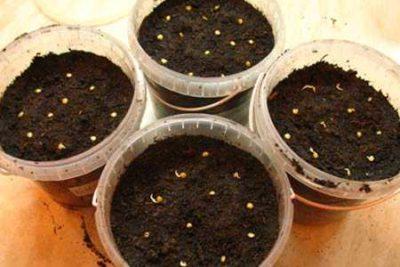

This is a more complicated and time-consuming process than reproduction with the help of children.- Young plants do not retain the varietal characteristics of their parents. At home, not very interesting specimens often grow.
- It is quite problematic to get seeds at home. This requires two simultaneously blooming stone roses, grown from different parents. In addition, as soon as the flowers begin to wilt, they must be urgently plucked. Otherwise, the peduncle will begin to dry out, and with it the entire outlet dies.
Important! If you remove the flower early, the seeds will not have time to ripen, if you let the peduncle dry, you can lose the entire plant, which is not advisable.
Children
Florists prefer to breed a stone rose with the help of children. This is due to the presence of a number of advantages of this method. The advantages of the method are:
- Ease. Daughter rosettes are formed in the leaf axils of an adult plant. They are connected to the maternal base by thin stems. Having grown a little, small rosettes crumble to the ground. They need to be collected and planted. You can not wait for this moment and carefully separate the young plants from the mother, then spread them on the soil.
- Reliability. This method provides excellent results - the plants take root better.
- The rooting process takes a little time. Children take root very quickly.
The disadvantage can be considered the fact that at home the young grows rather poorly and gives few children.
The process of formation of daughter processes can be accelerated. To do this, give the stone rose a lot of light - place the pot with the plant on a sunny windowsill.
Daylight hours must last at least ten hours... You can use fluorescent or special phytolamps for supplementary lighting. After a certain amount of time, babies begin to form in the leaf axils.
Watch a video about breeding rejuvenated by children:
How to choose kids?
Small daughter sockets are suitable for reproduction. After planting, large shoots often bloom and die off - the flowering of the rejuvenated occurs only once in the life of the plant. If the young is grown for the first time and there is no way to separate the baby from the mother's base on its own, the young shoot can be purchased in a specialized store or nursery.
Sowing
Sowing seeds can be done in late winter or early spring (February-March). You need to take a bag of seeds and distribute them evenly over the surface of the container. The seeds are buried into the ground by no more than 1 mm. It is not necessary to sprinkle it on top with earth.Can be lightly sprinkled with sand. Cover the container with foil or glass.
For good seed germination you need:
- Provide bright diffused light and a constant air temperature of about 23-25 ° C.
- The soil must be kept moist at all times. Watering is carried out 2 times a week.
- It is also necessary to provide ventilation of containers for 10-15 minutes a day, that is, remove the film or remove the glass.

